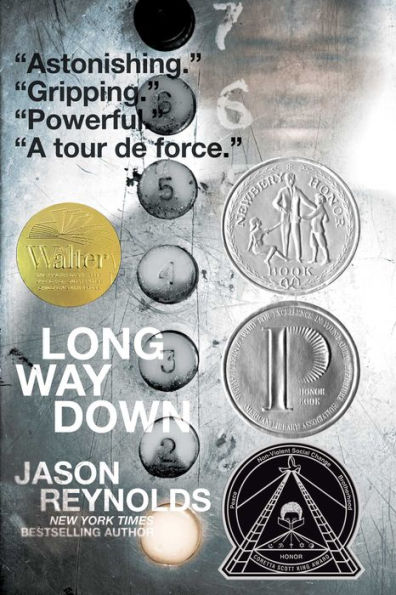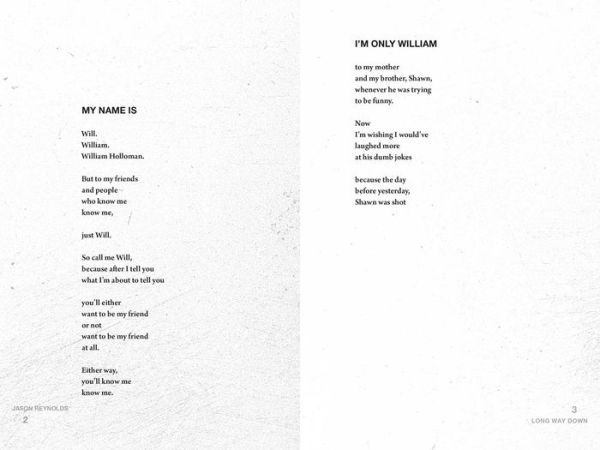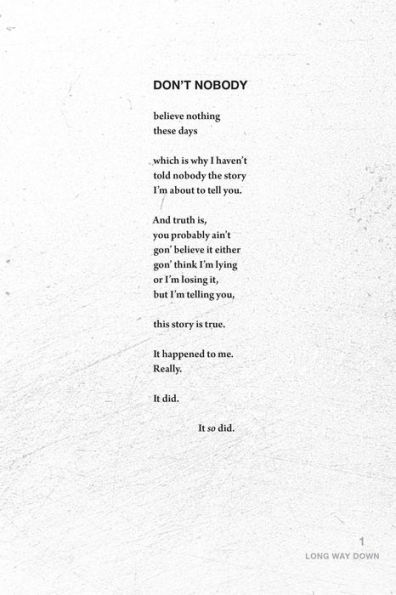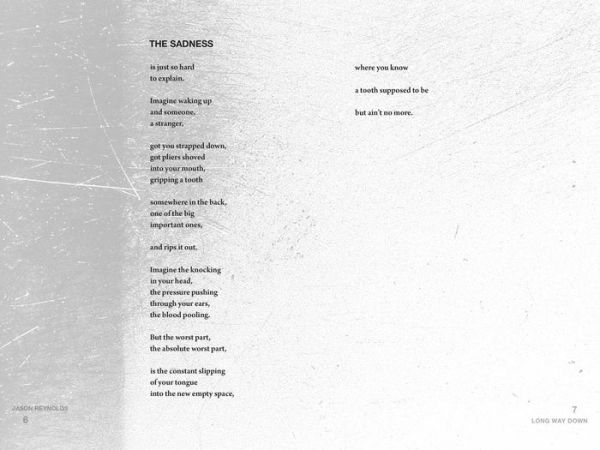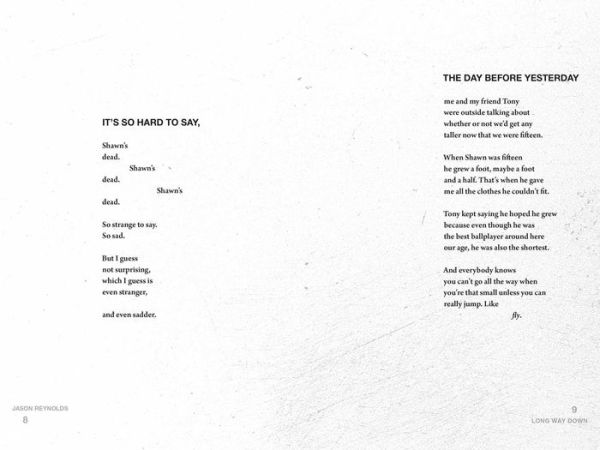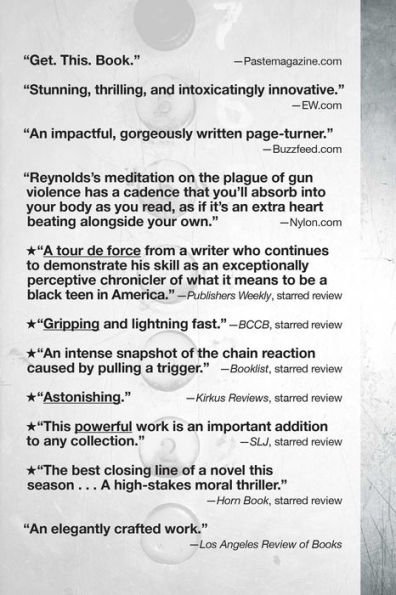Longlisted for the National Book Award for Young People’s Literature
Parents’ Choice Gold Award Winner
An Entertainment Weekly Best YA Book of 2017
A Vulture Best YA Book of 2017
A Buzzfeed Best YA Book of 2017
An ode to Put the Damn Guns Down, this is National Book Award finalist and New York Times bestseller Jason Reynolds’s fiercely stunning novel that takes place in sixty potent seconds—the time it takes a kid to decide whether or not he’s going to murder the guy who killed his brother.
A cannon. A strap.
A piece. A biscuit.
A burner. A heater.
A chopper. A gat.
A hammer
A tool
for RULE
Or, you can call it a gun. That’s what fifteen-year-old Will has shoved in the back waistband of his jeans. See, his brother Shawn was just murdered. And Will knows the rules. No crying. No snitching. Revenge. That’s where Will’s now heading, with that gun shoved in the back waistband of his jeans, the gun that was his brother’s gun. He gets on the elevator, seventh floor, stoked. He knows who he’s after. Or does he? As the elevator stops on the sixth floor, on comes Buck. Buck, Will finds out, is who gave Shawn the gun before Will took the gun. Buck tells Will to check that the gun is even loaded. And that’s when Will sees that one bullet is missing. And the only one who could have fired Shawn’s gun was Shawn. Huh. Will didn’t know that Shawn had ever actually USED his gun. Bigger huh. BUCK IS DEAD. But Buck’s in the elevator? Just as Will’s trying to think this through, the door to the next floor opens. A teenage girl gets on, waves away the smoke from Dead Buck’s cigarette. Will doesn’t know her, but she knew him. Knew. When they were eight. And stray bullets had cut through the playground, and Will had tried to cover her, but she was hit anyway, and so what she wants to know, on that fifth floor elevator stop, is, what if Will, Will with the gun shoved in the back waistband of his jeans, MISSES.
And so it goes, the whole long way down, as the elevator stops on each floor, and at each stop someone connected to his brother gets on to give Will a piece to a bigger story than the one he thinks he knows. A story that might never know an END...if WILL gets off that elevator.
Told in short, fierce staccato narrative verse, Long Way Down is a fast and furious, dazzlingly brilliant look at teenage gun violence, as could only be told by Jason Reynolds.
Longlisted for the National Book Award for Young People’s Literature
Parents’ Choice Gold Award Winner
An Entertainment Weekly Best YA Book of 2017
A Vulture Best YA Book of 2017
A Buzzfeed Best YA Book of 2017
An ode to Put the Damn Guns Down, this is National Book Award finalist and New York Times bestseller Jason Reynolds’s fiercely stunning novel that takes place in sixty potent seconds—the time it takes a kid to decide whether or not he’s going to murder the guy who killed his brother.
A cannon. A strap.
A piece. A biscuit.
A burner. A heater.
A chopper. A gat.
A hammer
A tool
for RULE
Or, you can call it a gun. That’s what fifteen-year-old Will has shoved in the back waistband of his jeans. See, his brother Shawn was just murdered. And Will knows the rules. No crying. No snitching. Revenge. That’s where Will’s now heading, with that gun shoved in the back waistband of his jeans, the gun that was his brother’s gun. He gets on the elevator, seventh floor, stoked. He knows who he’s after. Or does he? As the elevator stops on the sixth floor, on comes Buck. Buck, Will finds out, is who gave Shawn the gun before Will took the gun. Buck tells Will to check that the gun is even loaded. And that’s when Will sees that one bullet is missing. And the only one who could have fired Shawn’s gun was Shawn. Huh. Will didn’t know that Shawn had ever actually USED his gun. Bigger huh. BUCK IS DEAD. But Buck’s in the elevator? Just as Will’s trying to think this through, the door to the next floor opens. A teenage girl gets on, waves away the smoke from Dead Buck’s cigarette. Will doesn’t know her, but she knew him. Knew. When they were eight. And stray bullets had cut through the playground, and Will had tried to cover her, but she was hit anyway, and so what she wants to know, on that fifth floor elevator stop, is, what if Will, Will with the gun shoved in the back waistband of his jeans, MISSES.
And so it goes, the whole long way down, as the elevator stops on each floor, and at each stop someone connected to his brother gets on to give Will a piece to a bigger story than the one he thinks he knows. A story that might never know an END...if WILL gets off that elevator.
Told in short, fierce staccato narrative verse, Long Way Down is a fast and furious, dazzlingly brilliant look at teenage gun violence, as could only be told by Jason Reynolds.

Long Way Down
336
Long Way Down
336Paperback(Reprint)

Product Details
| ISBN-13: | 9781481438261 |
|---|---|
| Publisher: | Atheneum/Caitlyn Dlouhy Books |
| Publication date: | 04/02/2019 |
| Edition description: | Reprint |
| Pages: | 336 |
| Product dimensions: | 5.40(w) x 8.20(h) x 1.20(d) |
| Age Range: | 12 - 17 Years |
About the Author

Customer Reviews
Explore More Items
Now in graphic novel format, Lois Lowry’s Newbery Medal–winning classic story of a young boy
Trouble is brewing in Village. Once a utopian community that prided itself on
Left orphaned and physically flawed in a civilization that shuns and discards the
A National Book Award Finalist for Young People’s Literature
Nominated as one of America’s best-loved novels by PBS’s The Great American Read
Ghost wants
Ghost. Patina. Sunny. Lu. A fast but fiery group of kids from wildly different backgrounds,
Un superhéroe extraordinario que intenta pasar desapercibido bajo la identidad de Portico Reeves, un chico que vive en la casa más grande de la ciudad y a
In this Coretta Scott King Honor Award–winning novel, two
Nominated as one of America’s best-loved novels by PBS’s The Great American Read
Ghost wants to be the fastest sprinter
Jason Reynolds’s Newbery Honor, Printz Honor, and Coretta Scott King Honor–winning, #1 New York Times bestselling novel Long Way Down is now a gripping, galvanizing
"The perfect anchor leg for a well-run literary relay." --Kirkus Reviews Lu must learn to leave his ego on the sidelines if he wants to finally







